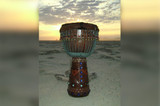Irish Bodhrán Frame Drums
The popular Irish frame drum, bodhrán, is rife with historical controversy. Regardless of where folks believe the drum to have originated, today it is a symbol of Irish pride and culture. St. Patrick’s Day is sure to see its fair share of the beloved instrument, but that is a rather recent phenomenon.
The bodhrán was only introduced to the world of musical instruments in the last sixty or so years. However, that has not stopped it from becoming the frame drum associated with Irish celebrations and music the world over.The bodhrán is pronounced in a way that rhymes with “cow brawn”. The emphasis when speaking is upon the first syllable and when playing is upon the tipper. Tippers are double-headed beaters that are usually used to play bodhráns, although they can also be played using only hands. Since tippers were originally fashioned from bone, they are sometimes referred to by that name. Plastic brush-ended beaters are now in fashion, although they are a modern bodhrán accessory.
For St. Patrick’s Day, people are bound to hear bodhráns played in just about every parade and celebration. The controversial origins and history of the instrument make it a wonderful talking piece. Some say it is a “poor man’s tambourine”, an instrument known to have been played in Ireland long before any documented proof of the bodhrán. In fact, the bodhrán is not a documented drum name at any time before the 17th century and even then, it was used as a war drum, not a musical instrument. Through the music of Seán Ó Riada and other musicians of the 1960s, the bodhrán gained legitimacy in the world of Irish music.
Like a typical frame drum, the bodhrán is a circular drum made of wood and an animal head, traditionally goat, sheep, or greyhound. These days you may find the drum constructed both traditionally and using synthetic heads. The traditional bodhrán construction included an internal tuning mechanism. Modern versions are more likely to have external tunables or tuning screws set through the actual rim.

While some historians say the bodhrán made its way to Ireland by way of the Spanish, who in turn picked it up from Africans, others say the instrument comes from Asia, brought to Ireland by Celtic immigrants. No matter where it originated, the frame drum is clearly here to stay. Coveted as a part of Irish identity, the bodhrán will be spotted at St. Patrick’s Day parties around the world. No longer a war drum, it will never the less be used to round up and arouse hordes of people, as any good drum should.
Recent Posts
-
What is the Best Size Djembe for Beginners?
If you're new to the world of percussion and interested in learning the djembe, you're in for a t …16th Jul 2024 -
The Benefits of Becoming a Drumming Teacher: Transforming Passion into Profession
Why become a drumming teacher? Becoming a drumming teacher is an excellent way to share your pas …22nd May 2024 -
What Makes the Djembe Drum a Spiritual Instrument in African Music?
Origin and history of the Djembe drum The Djembe drum originates from West Africa and holds sign …16th May 2024




